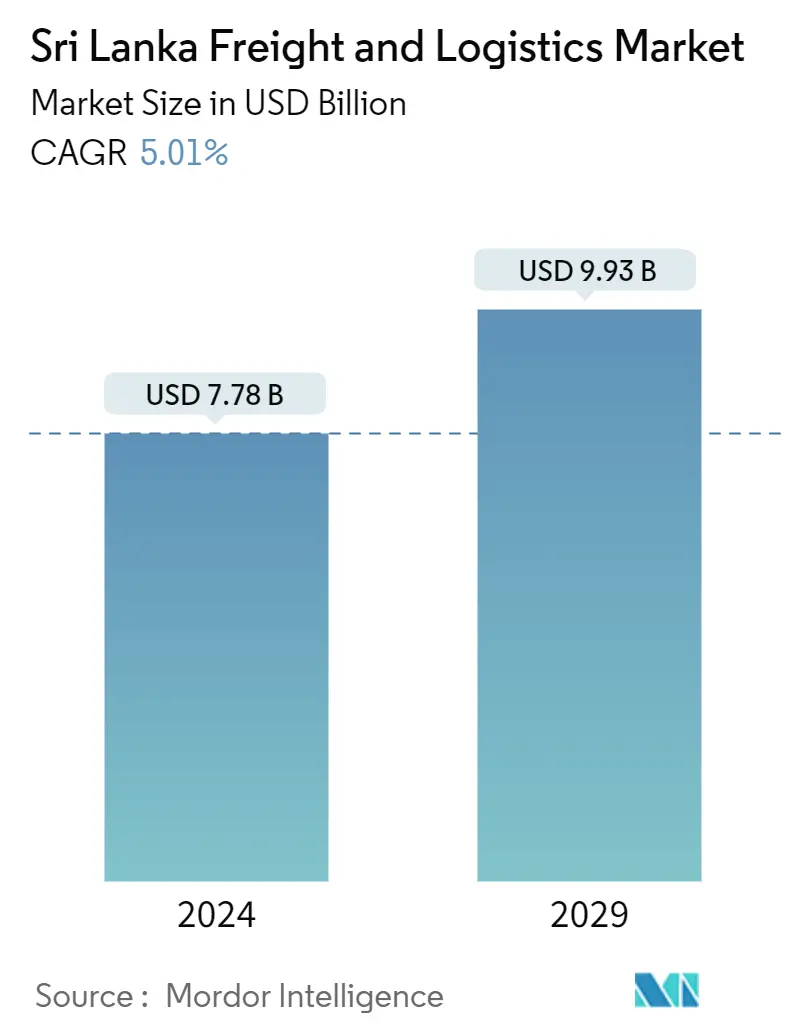Market Size of Sri Lanka Freight And Logistics Industry

| Study Period | 2019-2029 |
| Base Year For Estimation | 2023 |
| Market Size (2024) | USD 7.78 Billion |
| Market Size (2029) | USD 9.93 Billion |
| CAGR (2024 - 2029) | 5.01 % |
| Market Concentration | Low |
Major Players
*Disclaimer: Major Players sorted in no particular order |
Need a report that reflects how COVID-19 has impacted this market and its growth?
Sri Lanka Freight And Logistics Market Analysis
The Sri Lanka Freight And Logistics Market size is estimated at USD 7.78 billion in 2024, and is expected to reach USD 9.93 billion by 2029, growing at a CAGR of 5.01% during the forecast period (2024-2029).
- Growth in the e-commerce segment, higher internet penetration in the masses, and the latest technological innovations in the sector are the key driving factors in the market.
- The country's strategic location among the top air navigation and sea routes within the Southern Asian region has made Sri Lanka a lucrative destination for developing logistics. The COVID-19 pandemic impacted every sector. However, the pandemic accelerated online purchasing, which positively affected the industry's growth and increased its market share.
- During the last five years, Colombo Port has been ranked among the Top 50 World Container Ports above other South Asia ports by the World Shipping Council based on the volume of the containers handled.
- The Sri Lankan logistics sector contributes around 2.5% of the nation's GDP (gross domestic product), which represents about USD 2 billion, and the industry provides full-time direct employment to over 40,000 people. In addition to expanding its seaports, the country has the highest road density in South Asia, with around 174 km of roads per 100 sq km of land, connecting all major ports and airports.
- The growing recognition as a marine engineering hub in the South Asian region and the increasing capacity for offshore engineering has also benefitted the country to get more reputation as an emerging logistics hub providing a complete suite of logistic services.
- Sri Lanka aims to become a multimodal logistics hub by providing integrated services and facilities by developing physical, telecommunication, and information technology infrastructure between the air and seaport facilities in the future.
- Entrepót trade or the re-export trade involves importing goods from one country and re-exporting to another, with or without any additional processing or repackaging. Goods are exempt from duties at the point of import and re-export. The country has designated free ports and bonded areas, including Colombo Port, Hambantota Port, Mattala Airport, Katunayake EPZ, Koggala EPZ, Mirijjawila EPZ, and Colombo Airport Cargo Terminal to carry out entrepot trade.
- With the introduction of the commercial hub regulations through amendments made to the Finance Act No 12 of 2012 of Sri Lanka in the year 2013, a wide range of possibilities for entrepot trade in Sri Lanka, namely;
- Entrepót Trade under the Commercial Hub Regulations targeting foreign investors coming under the purview of the BOI, Sri Lanka.
- Entrepót Trade under the Customs Ordinance without entitlements to all of the benefits under Commercial Hub Regulations for local traders.
Sri Lanka Freight And Logistics Industry Segmentation
Freight refers to the transportation of goods through air, rail, and roadways. Logistics refers to the overall process of managing how resources are acquired, stored, and transported to their destination.
Sri Lanka's freight and logistics market is segmented by end-user industry (manufacturing and automotive, oil and gas, mining, and quarrying, agriculture, fishing, forestry, construction, and distributive trade) and by function (freight transport, warehousing, freight forwarding, and value-added services).
The Sri Lankan freight and logistics market report offers the market size and forecast value (USD) for all the above segments.
The report provides a comprehensive background analysis of the Sri Lankan freight and logistics market, covering current market trends, market dynamics, technological updates, and detailed information on various segments and the industry's competitive landscape. Additionally, the COVID-19 impact has been incorporated and considered during the study.
| By End User Industry | |
| Manufacturing and Automotive | |
| Oil and Gas, Mining, and Quarrying | |
| Agriculture, Fishing, and Forestry | |
| Construction | |
| Distributive Trade |
| By Function | ||||||
| ||||||
| Warehousing | ||||||
| Freight Forwarding | ||||||
| Value Added Services |
Sri Lanka Freight And Logistics Market Size Summary
The Sri Lanka Freight And Logistics Market is projected to show significant growth over the forecast period. This growth is primarily driven by the expansion of the e-commerce segment, higher internet penetration, and technological innovations in the sector. Sri Lanka's strategic location among top air navigation and sea routes within the Southern Asian region has positioned it as a desirable location for logistics development. The industry has also benefited from the increase in online purchasing due to the COVID-19 pandemic. The market is further bolstered by the country's robust infrastructure, including its seaports and road networks. Sri Lanka is gaining recognition as a marine engineering hub in the South Asian region, with increasing capacity for offshore engineering. The country is working towards becoming a multimodal logistics hub by developing its physical, telecommunication, and information technology infrastructure. Furthermore, the growth of sea freight transport and improving export performance are key trends in the Sri Lanka Freight And Logistics Market.
Explore MoreSri Lanka Freight And Logistics Market Size - Table of Contents
-
1. MARKET SEGMENTATION
-
1.1 By End User Industry
-
1.1.1 Manufacturing and Automotive
-
1.1.2 Oil and Gas, Mining, and Quarrying
-
1.1.3 Agriculture, Fishing, and Forestry
-
1.1.4 Construction
-
1.1.5 Distributive Trade
-
-
1.2 By Function
-
1.2.1 Freight Transport
-
1.2.1.1 Road
-
1.2.1.2 Rail
-
1.2.1.3 Air
-
1.2.1.4 Ocean/Sea
-
-
1.2.2 Warehousing
-
1.2.3 Freight Forwarding
-
1.2.4 Value Added Services
-
-
Sri Lanka Freight And Logistics Market Size FAQs
How big is the Sri Lanka Freight And Logistics Market?
The Sri Lanka Freight And Logistics Market size is expected to reach USD 7.78 billion in 2024 and grow at a CAGR of 5.01% to reach USD 9.93 billion by 2029.
What is the current Sri Lanka Freight And Logistics Market size?
In 2024, the Sri Lanka Freight And Logistics Market size is expected to reach USD 7.78 billion.
